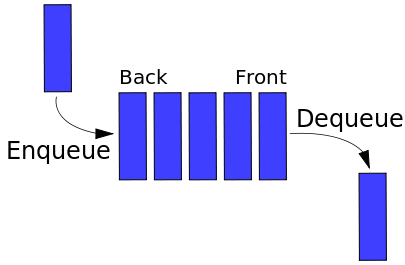Queue

In computer science, a queue is a particular kind of abstract data type or collection in which the entities in the collection are kept in order and the principal (or only) operations on the collection are the addition of entities to the rear terminal position, known as enqueue, and removal of entities from the front terminal position, known as dequeue. This makes the queue a First-In-First-Out (FIFO) data structure. In a FIFO data structure, the first element added to the queue will be the first one to be removed. This is equivalent to the requirement that once a new element is added, all elements that were added before have to be removed before the new element can be removed. Often a peek or front operation is also entered, returning the value of the front element without dequeuing it. A queue is an example of a linear data structure, or more abstractly a sequential collection.[2]
Access methods of stack[edit]
- push
- pop
- isEmpty
stack[edit]
This video discusses the C programming language, but the content is clear to describe stack.
Standards[edit]
- Describe the characteristics and applications of a stack.
- Construct algorithms using the access methods of a stack.
See Also[edit]
External Links[edit]
References[edit]
- ↑ http://www.flaticon.com/
- ↑ https://en.wikipedia.org/wiki/Queue_(abstract_data_type)
- ↑ This Image was created by User:Vegpuff.If you are using the image under the creative commons share alike license please credit the photo Vegpuff/Wikipedia and include a link to this page. No explicit permission is needed from me, but an email if my work has been of help to you.If you dont want to release your work under a creative commons license, please mail me at vegpuff@gmail.com or catch me at my twitter stream for a custom license. - Own work, CC BY-SA 3.0, https://commons.wikimedia.org/w/index.php?curid=7586271
